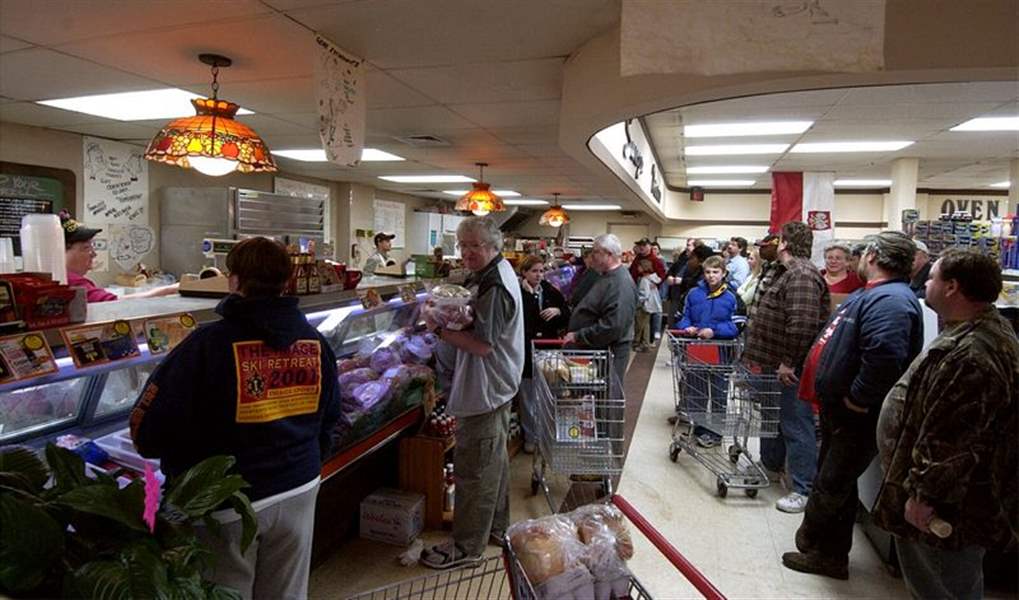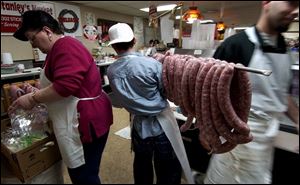
Easter is the time for 'kielbasa,' the Polish taste treat
3/26/2005
Customers wait in Stanley's Market at 3302 Stickney Ave. to buy some of the 26,000 pounds of kielbasa made for Easter.
Morrison / The Blade
Buy This Image

Kevin Chadwick totes a load of rings of kielbasa at Stanley's Market, where the air is heavy with the meat's garlicky scent.
Inspired by taste buds and family tradition, customers have clogged the parking lot and lined up two to three deep at a North Toledo market in recent days.
Their objective: Easter kielbasa.
"I come here every Easter," said Mary Aring of West Toledo as she waited for a clerk to shout her number yesterday morning at Stanley's 5-Star Market, 3302 Stickney Ave.
"My mother was Polish," she added. "She's dead now. But we follow in that tradition."
"The original Polish festival kielbasa," reads a large sign above the meat counter. The air is heavy with the garlicky scent of recently stuffed links. Nearby, clerks slap mounds of the sausage on an electronic scale whose digital display intermittently flashes "smaczne," meaning tasty.
For owner Joe Zychowicz, the heavy traffic is part of Easter's sweetness.
"We're tracking about 26,000 pounds," said the 54-year-old who makes the pork sausage from a recipe first used by his Polish-immigrant grandfather 70 years ago.

Customers wait in Stanley's Market at 3302 Stickney Ave. to buy some of the 26,000 pounds of kielbasa made for Easter.
At $3.40 a pound, it's not a bad haul.
And Easter is only the second-most popular time for kielbasa sales. "Christmas is bigger," he said. "There are more parties and bigger parties."
In a usual week, the store sells about 1,000 pounds of the sausage, said Mr. Zychowicz.
Sausage makers were once commonplace in the North Toledo neighborhood founded by Polish immigrants in the late 19th century, especially along its commercial corridor, Lagrange Street. But the markets closed as descendants of the settlers moved and ties to the old country loosened.
Mr. Zychowicz's grandfather, also named Joe, operated a market at Elm and Dexter streets for many years beginning in the 1930s. He was joined by son Gene, the younger man's father. The family purchased Stanley's, which opened in the 1930s, in 1955.
To meet Easter demand, kielbasa production begins a week before the holiday and continues for seven days. Two to three workers are assigned to cut the pork shoulder into pieces while a second crew of four stuff a mixture of meat and spices -including marjoram -into natural casings.
Sales have held steady in recent years, the owner said. Consistency, quality, and a lean product are the keys to the product's popularity, he added.
Ironically, however, the product that is so identified with Poland is not commonly served in most homes and restaurants there. While Poles eat lots of kielbasa -a generic term that covers many varieties of sausage-it is usually a reddish-brown smoked product often marketed in the United States under the name Polish sausage.
But that doesn't discourage buyers.
"We're buying eight pounds, even though there are going to be only 13 people," Ms. Aring of West Toledo said sheepishly. "We love it."
Added Henrietta Welber, also of West Toledo:
"There's something about the flavor -it's so good. It's an Easter tradition."
Contact Gary Pakulski at:
gpakulski@theblade.com
or 419-724-6082.